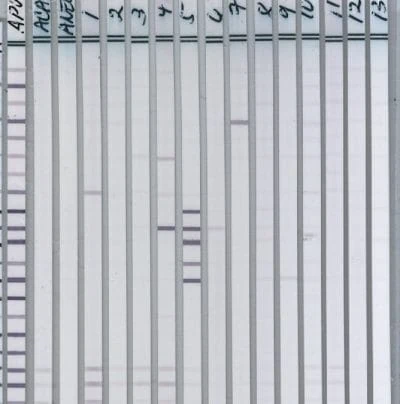OVERVIEW
The Western blot technique for detecting antibodies to tick-borne diseases was introduced in the late 1970s. Technological advancements over the past 50 years have lead to tests that go beyond what can be accomplished with the Western blot. The most significant advancement has been the introduction of the IGeneX ImmunoBlot. The IGeneX ImmunoBlot has two key differentiators. First, it looks for multiple pathogens, instead of one with the Western blot. And second, it uses recombinant proteins instead of proteins from natural sources, leading to a more specific test.
ADVANTAGES OF THE IGENEX IMMUNOBLOT
- Requires only one test to detect multiple species. Western blotting would require multiple tests.
- Uses specifically created recombinant proteins and not proteins from cultures
- Produces consistent bands that are easier to interpret
- Detects the full spectrum of disease: early, active, and late-stage
- Does not require a confirmation test

The difference is clear. ImmunoBlots are clear, precise, and easy to interpret.
how the igenex immunoblot is made
The IGeneX ImmunoBlot uses recombinant proteins instead of proteins from natural sources. Recombinant DNA technology provides a more efficient method to obtain large amounts of proteins. Additionally, by using recombinant technology, IGeneX scientists are able to create DNA sequences that would not naturally exist under normal circumstances, leading to more sensitive and specific tests.

1. ISOLATE THE GENES
Pure genes are stored and ready to be cloned by IGeneX researchers.

2. EXPRESS THE GENES

3. PURIFY THE PROTEINS

4. SPRAY THE PROTEINS
IGENEX IMMUNOBLOT SENSITIVITY IS FAR BETTER THAN A COIN FLIP
Common Lyme two-tier testing has a sensitivity of just above 50% because it detects only one Borrelia species, B. burgdorferi B31. The IGeneX ImmunoBlot detects antibodies to nine different species of Borrelia: B. burgdorferi B31, B. burgdorferi 297, B. californiensis, B. mayonii, B. afzelii, B. garinii, B. spielmanii, B. bissettii, and B. valaisianaa.

1. The Accuracy of Diagnostic Tests for Lyme Disease in Humans, A Systematic Review and Meta-Analysis of North American Research. PLoS ONE 11(12): e0168613.
2. Pilot Study of Immunoblots with Recombinant Borrelia burgdorferi Antigens for Laboratory Diagnosis of Lyme Disease
3. An ultra-high-density protein microarray for high throughput single-tier serological detection of Lyme disease
IGENEX IMMUNOBLOTS ARE AVAILABLE FOR FOUR DISEASES

Lyme Disease ImmunoBlots
The IGeneX Lyme ImmunoBlot detects antibodies to nine different species of Borrelia: B. burgdorferi B31, B. burgdorferi 297, B. californiensis, B. mayonii, B. afzelii, B. garinii, B. spielmanii, B. bissetti, and B. valaisianaa. By testing for more species than the traditional ELISA and western blot tests, the IGeneX ImmunoBlot reduces the risks of false negatives.

Tick-Borne Relapsing Fever (TBRF) ImmunoBlots
Some of the Borrelia that causes TBRF are transmitted by the same ticks that transmit B. burgdorferi, the causative agent of Lyme disease. Therefore, it is crucial to test for both TBRF and Lyme. The IGeneX TBRF ImmunoBlot detects antibodies to species from North America, European and Australian strains. The most common species are B. miyamotoi, B. hermsii, and B. turicatae.

Bartonella ImmunoBlots
Diagnostic tests for Bartonella, such as IFA, have not been able to detect many of the ever-growing list of species and strains. The IGeneX Bartonella ImmunoBlots are designed to detect IgM and IgG antibodies to multiple Bartonella species including B. henselae, B. quintana, B. elizabethae, and B. vinsonii.

Babesia ImmunoBlots
Babesia is the most common Lyme disease co-infection. The IGeneX Babesia ImmunoBlot tests for the Babesia genus and speciates to multiple species of Babesia that infect humans, including B. microti and B. duncani. This test is the first ever application of advanced recombinant technology for the serodiagnosis of Babesiosis.
WHY IGENEX FOR TICK-BORNE DISEASE TESTING?

- CLIA certified in all 50 states
- Long track record of success since 1991
- Offers testing that is nearly twice as accurate as CDC recommended tests
- Tests for all major tick-borne illnesses, including Lyme disease, TBRF, Babesiosis, Bartonellosis, Anaplasmosis, Ehrlichiosis, and Rickettsiosis
- Utilizes comprehensive testing methods such as PCR, cePCR, ImmunoBlots, IgXSpot, FISH, IFA, ELISA, LDA, and LSA
Get in Touch
If you are a physician and would like to learn more about IGeneX or our tick-borne disease testing products, let us know by completing the form below or calling us at 1-800-832-3200. If you are a patient, please do not use this form. Send an email to customerservice@igenex.com or call us at 1-800-832-3200.




